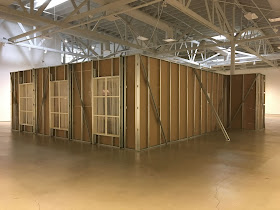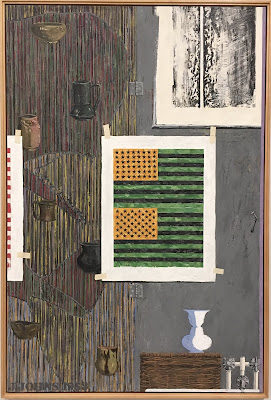For more complete coverage, visit the ICA, LA website for this exhibition at the following:
Sunday, April 22, 2018
Friday, April 13, 2018
Damien Hirst "The Veil Paintings" @ Gagosian | Beverly Hills
Veil of Perfect Harmony, 2017
Oil on canvas
120 x 90 inches
Veil of Faith, 2017
Oil on canvas
144 x 108 inches
Veil of Eternal Happiness, 2017
Oil on canvas
108 x 72 inches
Veil of Love Everlasting, 2017
Oil on canvas 120 x 90 inches
The confectionary aspect of this work is unmistakable and in line with other Hirst works, even diamond-encrusted skulls. What I can’t figure out is what compels me to view these works or even consider them further. Perhaps it’s the train-wreck factor, which is to say it’s like a car wreck that one can’t top looking at, which leads me to Andy Warhol and then it starts to make sense as sensational, the easy fix of glitter or cake frosting. That said, once digested, its sustainability is a short-lived thrill, again like a pop-tart, pop-art, pop-song. Typically this would lead to a desire for more (kind of like crack), but in the case of these paintings not so much.
What is worth considering is how colors interact spatially at what distance and how no amount of resolution will actually resolve such abstract conditions. For a moment, I was going down the road of a Wayne Thiebaud gum ball painting before I started thinking more carefully about how these paintings situate within the larger context of painting history, generally, and, seemingly more importantly, Damien Hirst, specifically. Throughout his career there have been moments of color understanding, let’s call it, where it seems like he’s throwing everything at the canvas or conversely organized (the same back and forth of Gerhard Richter in certain respects) in some kind of holistic attempt to understand infinitude (the sublime) and its alter or its extra. Whatever the case, the body of works seems all over the place, questionable at best, especially in its return and lack of development beyond the early 90’s Visual Candy Series. See here.
Twenty-plus years ago, I was curious about the formaldehyde sculptures a more direct confrontations with visages of time, slices of reality in a way that slices of cake could never.
James Crosby "Forms Between" @ team (bungalow)
Abstraction, 2018
Acrylic, vulcanized rubber, cotton hoodies, rapid expanding foam
28 x 40 x 46 inches
the Garrett Morgan safety hood allowing the wearer to breathe in a hostile environment, 2018
Fabricated coat/hat rack, heavy canvas, plexiglass (sic)
36 x 72 x 6 inches
It's not always clear, in the moment or later, why something resonates. Lights and darks commingle as light itself in and around the space as well as in and around each object. They are inseparable with respect the thing itself and its metaphor. At the time, I thought nothing (itself yet another kind of absence/non/darkness). In hindsight, I thought of David Hammon's "In the Hood (Gray)." See below or here for more details.
David Hammons
In the Hood (Gray), 2016
Athletic sweatshirt hood, wire, monofilament
Won Ju Lim "Aunt Clara's Dilemma" @ DXIX Projects
Witches Corner, 2018
Single image projection, wallpaper
Variable measurements
While there were other works in the show, I was drawn to the one that seemed most engaged with the immediate situation, the architecture and a curious aperture made prominent by the anamorphic projection of an interior space, a seemingly dated setting not unlike what one might see more readily in a 1970's sitcom, fictional to be sure. An other world... Still.
The following is a statement written to accompany the exhibition. I copied it from the website.
1. Space is a word that makes something of the nothing that surrounds us. Continuous and everywhere identical, space, once it is designated as such, can be subdivided into spaces. A line drawn in the sand gives two sides to space; a wall erected on the line fortifies the division; and with the addition of adjoining, enclosing walls, an interior is excerpted from the exterior. But were this structure left without any opening, it would merely be a thing in space. The delimiting function of walls would amount to nothing without the addition of entrances and exits.
2. During his period of exile in Los Angeles, Theodor Adorno heard sounds of slamming all around him. “What does it mean for the subject that there are no more casement windows to open, but only sliding frames to shove, no gentle latches but turntable handles, no forecourt, no doorstep before the street, no wall around the garden?” The attrition of the threshold in the American home, while seeming to promise greater transparency to the street and a refreshed spirit of civic conviviality, does just the opposite. All attention is drawn toward the remaining barrier, which takes on a sinister and oppressive mien. Particularly vexing for him was this “turntable handle” – the industrialized retooling of the old lever handle – the doorknob. “Thus,” he writes, “the ability is lost to close a door quietly and discretely, yet firmly.” A whole dialectics of outside and inside dissolves around the turn of the wrist coaxed by this domestic accessory.
3. Witches, as they appear on the television sitcom Bewitched (1964-1972), are figures perfectly at home in continuous space. Doors present no obstacle to them. With an effortless snap of the fingers or a twitch of the nose they can pierce the rigid boundaries of private life, a wanton transgression of the spatial economy of mid-century suburbia. The show’s protagonist, Samantha, must suppress her magical powers to suit the wishes of her continually alarmed husband, Darren. This is a problem, although it pales next to that of her Aunt Clara, whose powers are on the wane. Unable to clear the hurdle of the door in her old age and encroaching senility, Aunt Clara becomes a fetishistic collector of doorknobs.
4. Aunt Clara’s Dilemma is an exhibition by Won Ju Lim about doorknobs, thresholds, and the moment when the old dialectic of outsides and insides becomes a mise-en-abyme. There have always been doors, and doors, in order to be opened and closed, have always been equipped with handles. Once they were carved by hand to fit back into the hand. Then machines inherited the task as a standardized ergonomic ratio. Now, the machines, having progressed to customized algorithms, deliver a handle that could directly respond to your hand. As the old model Apple computers once asked, “Where do you want to go today?”
__________________________________________________________
A model version of Aunt Clara’s Dilemma was be presented in Alice Konitz’s LAMOA, DS#3 located at Commonwealth and Council.
Artist’s website: https://www.wonjulim.com/
LAMoA’s website: http://losangelesmuseumofart.blogspot.com
DXIX Projects website: https://www.dxixprojects.com/program.html
Sunday, April 8, 2018
Jasper Johns "Something Resembling Truth" @ The Broad
Ventriloquist, 1983
Encaustic on canvas
190.2 x 127. 3
Bridge, 1997
Oil on canvas with objects
198.1 x 299.7 cm
The Critic Sees, 1961
Sculpt-metal on plaster with glass
7.9 x 16.5 x 5.4 cm
0 through 9, 1961
Oil on canvas
Dancers on a Plane, 1980
Oil on canvas with patinated bronze frame
200 x 161.9 cm
Celine, 1978
Oil on canvas (two panels)
215.9 x 122.6 cm
Field Painting, 1963-1964
Oil on canvas with objects (two panels)
182.9 x 93.2 cm
I went to see this exhibition twice, once with my family and once with a long-time friend and fellow Johns enthusiast. As with all shows of this magnitude, it's a lot to take in, not just once but twice. For what it's worth, doubling and the nuances of dualisms of all kinds are persistently present in Johns, especially as keyed by the marquis work, Painting with Two Balls. You be the judge. In fact, that does seem to be an important point to the work, a certain ambiguity, a certain lack of resolution, a certain mount of uncertainty, and therefore a resemblance of truth, whereby it actually may or may not be so, again dependent on the viewer, I think. Once more, you be the judge. Aside from whatever coy plays/ploys between language and phenomena, this body of work seems to revel and succeed in balancing both.
























































